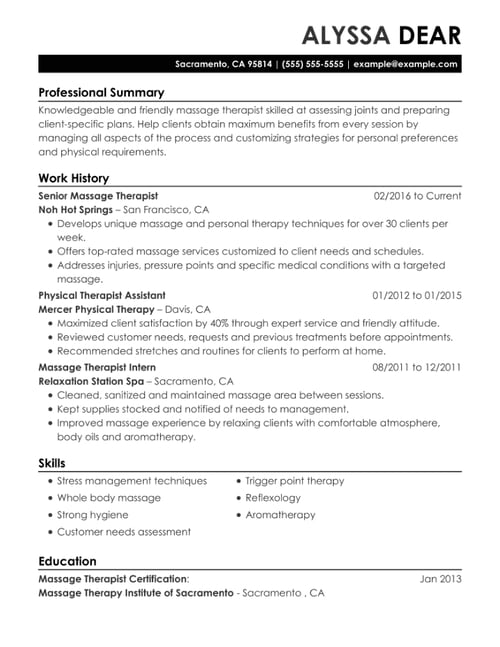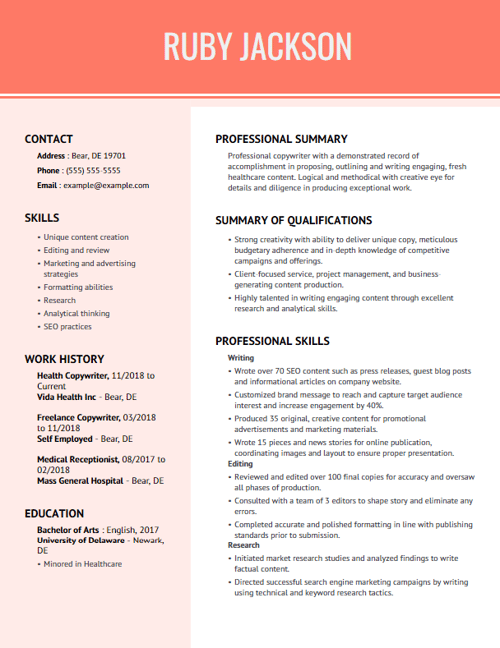The content of your resume is as important as the format used in presenting the resume. Put another way, crisp resume content plus the best resume format is the perfect match for getting hired for a role.
![→ Download Now: 12 Resume Templates [Free Download]](https://no-cache.hubspot.com/cta/default/53/4ec95757-585e-40cf-9189-6b3885074e98.png)
In this post, you’ll learn about the best resume formats, their pros and cons, and when to use each one. Let’s dive in.
Table of Contents
What are the different resume formats?
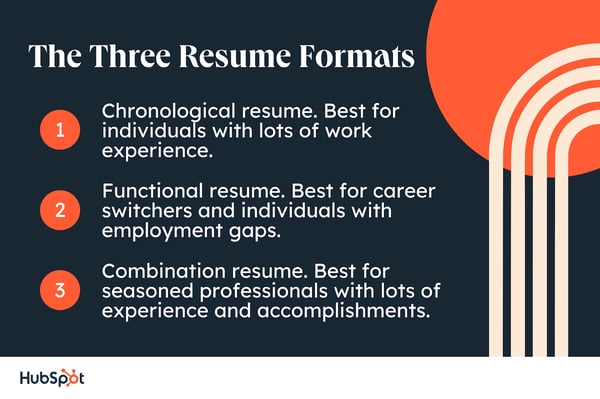
There are three standard types of resume formats:
- Chronological resume. This resume shows your relevant work experiences and achievements, beginning with the most recent one. It’s the most used of the three resume formats and suits people with lots of work experience.
- Functional resume. This resume emphasizes your skills over your work experience. It suits anyone who’s switching careers and individuals who have employment gaps.
- Combination resume. As the name suggests, this resume format blends the first two. It highlights both your skills and experiences but presents them chronologically. The combination resume is most suitable for seasoned professionals with lots of work experience and accomplishments.
Let’s consider how each of these resume formats works.
Chronological Resumes — How do they work?
All factors considered, chronological resumes are the best all-around choice for job seekers.
Below is the typical structure of a chronological resume:
Limitations of Chronological Resumes
1. Chronological resumes make career gaps obvious.
2. Chronological resumes could bury early career achievements.
3. Chronological resumes are not ideal for recent graduates or career switchers.
Recent graduates and career switchers typically lack related work experience.
Best Practices for Writing a Chronological Resume
1. Craft a compelling summary.
2. Highlight achievements, not responsibilities.
See how Jeff Su tweaks his resume to show his achievements rather than using meaningless buzzwords:
3. List relevant job experiences only.
4. Don’t place your Education above your Work Experience section.
Examples of Chronological Resumes
1. Management Consultant
- Sells his value using meaningful metrics. Quantifying the impact of one’s contribution using percentages, revenue, and other meaningful metrics should be a popular resume-writing best practice. Yet, only 26% of resumes included at least five instances of measurable results. Plus, 36% of resumes use no metrics, according to Austin Belcak’s analysis of 125,000+ resumes.
- Excludes a resume summary. Including a summary will turn this one-page resume into two pages. Those are less desirable alternatives. We suspect that’s why Jeff excluded the resume summary, and that’s smart in this case.
2. Massage Therapist
- Tells a compelling career story. This resume shows a clear career path from massage therapist intern to senior massage therapist within five years.
- Easy to read. Many resumes are cluttered and hard to scan. This one is readable.
Functional Resumes — How do they work?
This format is ideal where you’d rather show your skills than your career progression.
Limitations of Functional Resumes
1. Functional resumes are stigmatized by recruiters.
When recruiters see a functional resume, they become suspicious. They imagine you have something to hide. This makes them less likely to read your resume thoroughly.
2. Functional resumes don’t tell the full career story.
Beyond stigma, recruiters are sometimes interested in the information a functional resume hides.
3. Functional resumes are less ATS-friendly.
Best Practices for Writing a Functional Resume
1. Include relevant skills only.
2. Describe your skills using keywords from the job ad.
3. Exclude skill bars.
What’s worse? They make your resume less ATS-friendly. So it’s safer to stay away from them.
4. Include your work history.
Examples of Functional Resumes
Now let’s turn to some examples to see this resume format in action.
1. Health Copywriter
- Shows relevant, niche experience. The resume shows industry knowledge by revealing that the applicant minored in healthcare and has working experience as a medical receptionist and health copywriter.
- Quantifies impact using figures. The applicant uses percentages and other meaningful metrics to describe the impact of their work.
2. Medical Assistant
- Shows career trajectory. This resume shows the candidate’s career trajectory from being a medical receptionist to a medical assistant. That’s something you don’t always see in functional resumes.
- Minimal and easy-to-scan layout. Given the abundance of white space, the candidate could have included visual elements such as skill bars or pictures, but the applicant did not. This makes it easy to read and keeps the focus on what matters.
Combination Resumes — How do they work?
It then supports those skills with a chronological timeline of your relevant work experience.
Limitations of Combination Resumes
1. Combination resumes are challenging to prepare.
2. Combination resumes may appear repetitive.
Best Practices for Writing a Combination Resume
1. Tailor every experience to the job position.
Consider preparing a master resume or what Austin Belcak calls a results tracker. This is a long, regularly updated journal containing every job, project, and accomplishment you’ve had.
That way, you can quickly collect relevant experience and tailor your resume to job openings.
2. Expand on the results accomplished with each skill.
When filling out the skills section, you may list your key skills without elaborating. However, including a bullet list of your past responsibilities and accomplishments for each skill is more impactful.
3. Order your skills strategically.
The order of presenting your skills matters. Ideally, you should prioritize the skills listed in the job description and those most important in your field, listing your accomplishments under each skill category.
And while you’re at it, ensure you’re first showing skills that help you front-load your most significant achievements.
Examples of Combination Resumes
Review the examples below to see how two candidates created impactful combination resumes.
1. Marketing Manager
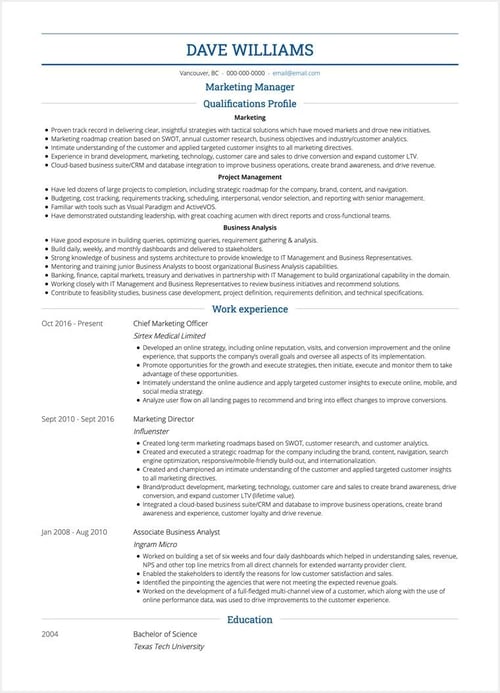
Image Source
What we like:
- Relays past responsibilities and achievements for each skill using bullets. Using bullets makes a resume easy to scan and read when done correctly. However, some of these bullets have meaningless buzzwords that do not illustrate the candidate’s value, quantify results, or grab attention.
Pro tip: Avoid repeating the same skills between the skills and experience sections. While the first should obviously highlight your skills, use the second to share your achievements.
2. Senior Software Engineer
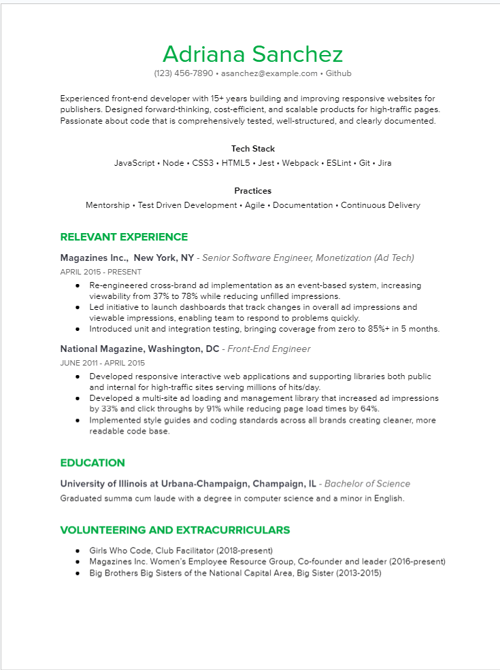
Image Source
What we like:
- Crisp, compelling, and digestible resume summary. The resume summary is easy to read, which is great since recruiters scan resumes quickly. It also sets a nice tone for the rest of the resume.
- Tells a compelling career story. This applicant’s career spans 15+ years in the publishing industry. Yet, the applicant has only worked two jobs. That shows commitment and indicates the candidate does great work.
Pro tip: Only include extracurriculars and volunteering if those activities are relevant to the position you’re applying for and if they highlight achievements that you didn’t also have in your professional career.
Writing a Winning Resume
Your desired role is only a few applications away. And you now know how to determine the resume format that best suits your situation.
So choose the best resume format that works for you, and create a winning resume that lands your dream role. You can also get started with our resource library of resume templates.
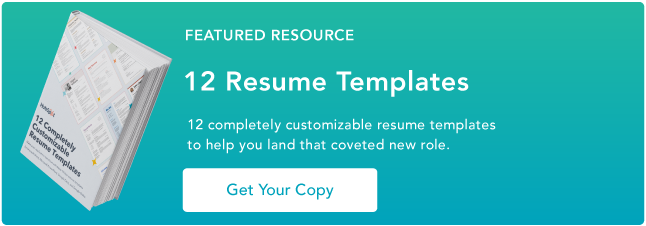
Credit: Source link



